OSD is a great addition to multicopter FPV flying. In this article we will look into what an OSD is and the benefits of using it. We will also cover how we connect an OSD to our FPV system, and finally we will go through a few popular OSD’s and the features they offer.
For more mini quad components suggestions, check out our mini quad parts list.
What is OSD and the Benefits
OSD stands for “On Screen Display“. It basically overlays flight information onto your FPV video feed.
For quadcopters, OSD hardware can exist as an external device in the form of a small PCB board, or it can be integrated into another device, such as your flight controller, PDB or FPV camera. It allows you to monitor your quadcopter status in real-time while flying FPV.
You can display flight data of your choice on your FPV goggle or monitor (if they are available), such as battery voltage, how much current the quadcopter is drawing, your altitude, distance from takeoff point, GPS coordinates etc. OSD can make FPV safer if you know the status of your craft.
OSD is not necessary for FPV flying, but as you can imagine it’s a powerful tool. I recommend at least get a simple OSD to display battery voltage to avoid over-discharging your LiPo, because as you fly further away, the low voltage alarm is harder to hear.
The types of data can be displayed on OSD
Here are some of the most common types of data that are displayed in an OSD.
Table of Contents
Timer
Depending on the type of OSD you have, this could be “flight time” (from the second the multicopter is armed), or “on time” (from the second the quad is powered on).
Battery Voltage
This is the most basic and essential feature of an OSD, therefore nearly all OSD units support voltage reading. Battery voltage reminds the pilot to land before over-discharging the battery. Remember that LiPo batteries suffer from voltage “sag” so with high throttle inputs your voltage will drop quickly but will usually recover slightly when the throttle is returned to a lower level.
Current
With a current sensor you will be able to monitor how much current is being drawn from your LiPo battery, and the total mAh consumed during a flight. As long as your current meter has been properly configured, the total “mAh drawn” is actually a more reliable indicator than voltage for determining how much of your battery capacity you have used.
Further Reading: When to land a quadcopter?
RSSI
RSSI is the indication of your radio signal strength, usually displayed as a percentage in OSD. The further you fly away the weaker the signal will be, with this info you know when you should head back.
Warning
Some OSD allows you to set up alarms, to alert you when critical values are reached, such as the battery voltage level, or RSSI being too low and so on.
Flight Mode
Shows the current flight mode of your quadcopter. It’s useful if you switch frequently between flight modes like manual, self-level or loiter mode, so you don’t get confused what mode you are currently using.
GPS
By using GPS, not only do you get the coordinates of your drone, you also get altitude data (although it’s more accurate with a barometer or sonar sensor). Thanks to some clever calculations, you can also get the ground speed of your multicopter, the distance from your take-off point, and home direction (A graphical indication to which direction you should fly back, a very helpful feature in case of loss of orientation)
Artificial Horizon
This is a virtual horizon, usually displayed as a line in the center of the screen (when your craft is level) to help the user with roll axis balance. The horizon line is determined by the attitude of the craft using the accelerometer. However some acro pilots prefer to disable the accelerometer, which will also disable virtual horizon.
OSD Connection with Camera / VTX / Flight Controller
The connection of OSD depends on which of the following types the OSD is:
- External/Standalone OSD
- FC dependent OSD
- Hybrid type (can be connected to the FC or used as a standalone OSD)
- OSD integrated in FC/PDB
- OSD built-in FPV Camera
External OSD
A standalone OSD doesn’t talk to the flight controller, and only connects between the camera and VTX. It might also connect to GPS and other sensors directly if supported. A good example would be the Skylark OSD (GPS/Current Sensor) or Super Simple OSD.
FC dependent OSD’s rely on data supplied by the flight controller, they usually are passed through a serial port (RX / TX). On its own the OSD does nothing apart from overlaying text on the screen. The MinimOSD from Hobbyking is a good example. One advantage of this type of OSD is, while OSD is getting flight data from the sensors on FC, the sensors can also be used by the FC to assist flying. A standalone OSD system, sensors/GPS connected to OSD are not shared with the flight controller.
Hybrid type OSD can be used as a standalone OSD or connects to the flight controller for richer range of flight data. The MinimOSD with KV team Mod is a good example: when used as standalone, you can display RSSI and voltage. But when used with a flight controller with GPS connected, you can display flight mode, GPS data, altitude and so on.
Here are some connection examples.
Simple Connection Example – Standalone OSD
As an example, this is the connection of Hobbyking Super Simple OSD, with FPV camera, video transmitter VTX, and a 3S LiPo battery. You can monitor a second battery with Bat2 port.
Advanced Connection Example – Hybrid OSD
Note that with this MinimOSD, battery voltage reading and RSSI are measured right on the OSD, although it’s also possible to connect both of these to the FC instead, and pass this info via serial port, both ways work just fine.
Of course you can also connect a GPS module to the Flight Controller if you want GPS data like coordinates, home distance, home direction etc displayed on your FPV video.
FC Integrated OSD
This type of OSD is widely used in Betaflight flight controllers, and the connection is much simpler. Here is a detail guide to setting up Betaflight OSD.
OSD built-in FPV camera
Often the built-in OSD in FPV cameras can only display LiPo voltage and timer.
OSD’s that I have Tried
Betaflight OSD
If you fly mini quad and love Betaflight firmware, you cannot go wrong with this. The integrated OSD saves you from wiring nightmare and hassle of flashing the OSD firmware.
Here is a detail guide to setting up Betaflight OSD.
MinimOSD
MinimOSD is a powerful device and used to be my favorite before FC integrated Betaflight OSD came out. With the correct firmware installed, it can be used with many different FC including the Naze32, CC3D, Multiwii boards, APM and PixHawk. It’s very powerful as it can display literally any flight information as long as it is available.
With the latest firmware, you can even tune your PID with the OSD menu. Here is a tutorial on how to setup MinimOSD with Naze32.
MinimOSD Micro
Basically the same OSD as the MinimOSD but in a much smaller form factor. Be aware that it doesn’t have the 12V to 5V voltage regulator though. People tend to power the MinimOSDD with 5V anyway due to regulator overheating issues. You can flash and program MinimOSD with Arduino.
BrainFPV
BrainFPV is a flight controller that has built-in OSD system, which can be configured through the FC software client. it’s perfect for those who don’t want to mess with wiring, and desire a clean, compact FPV system.
Skylark OSD
The Skylark OSD is a standalone GPS OSD system. It can display GPS (coordinates, home distance, altitude, speed), current, battery voltage, timer.
It was one of the first OSD systems and I used (with the KK2 FC a long time ago). It was a great option as I was looking for an OSD that didn’t need to connect to the FC, yet was capable of showing GPS info. Skylark OSD did the job well, and it usually found GPS satellites within seconds. The OSD system comes with a GPS module as well as a current sensor.
I only moved away from it as I started flying mini quad. It’s simply too bulky for small size models.
Super Simple OSD
Like the name suggests, it’s super simple to connect and setup, and does the job well. It’s one of the very few simple OSD’s that is rated up to 4S (2S-4S ), though the accuracy is not as good as the E-OSD (which is only rated up to 3S). It can only display battery voltage and timer.
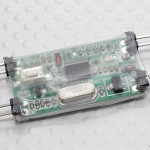
Hobbyking E-OSD
I would recommend this OSD to anyone who wants a simple solution when running 2S-3S on your multicopter. It’s also “hack-able”, by flashing it with customized firmware, you can display RSSI data with the secondary battery input (BAT2). However it is only capable of displaying battery voltage and timer.

Edit History
- Jun 2015 – Article created
- Aug 2017 – Updated info – Betaflight OSD
- Aug 2018 – Edited


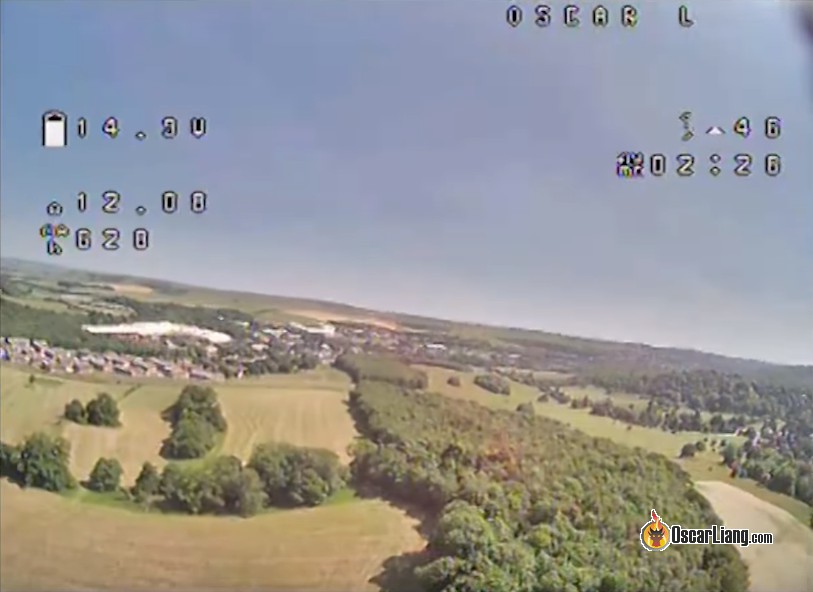



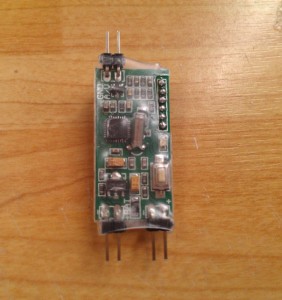

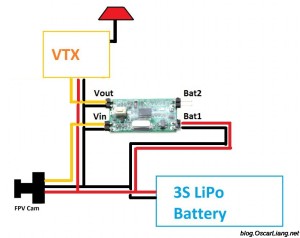
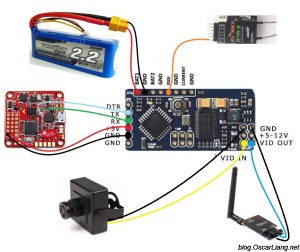
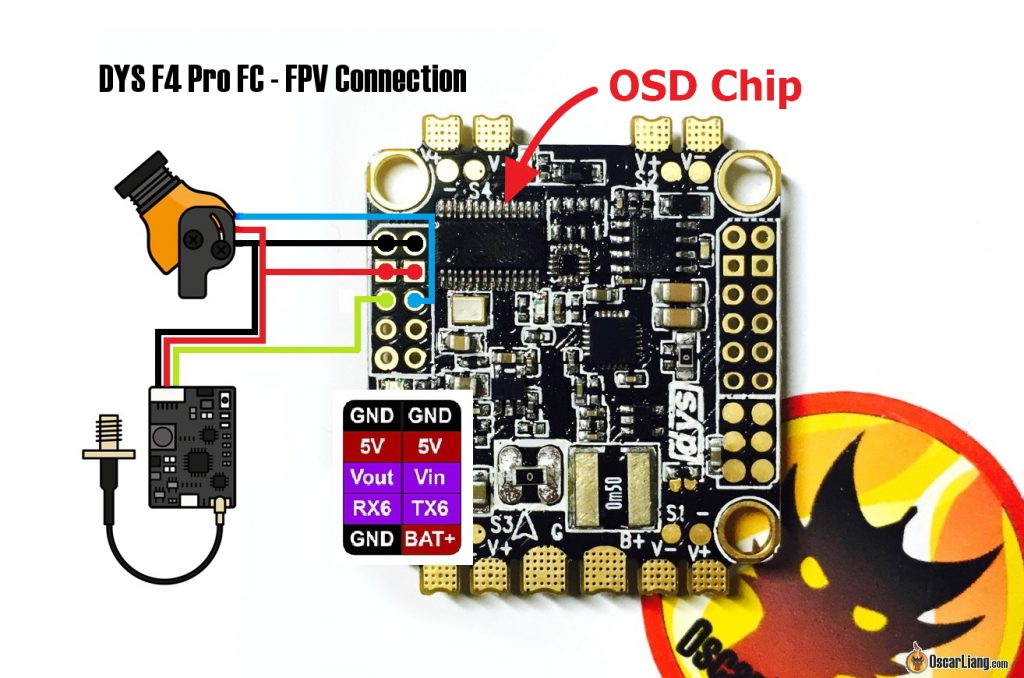



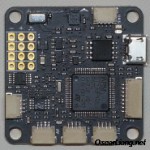
32 comments
hey Oscar,
Appreciate all the time and work you do, has been a really great to a lot of people.
I was wondering where I could find a schematic on an osd integrated into a flight controller, connection to the processor, components needed to make it work, etc. I’m trying to get a better understanding the how’s and whys.
Any help or direction would be greatly appreciated.
Thanks
Hi Oscar,
I am using the Xrotor F4 G2 FC, the Tramp HV and the RunCam Swift 2-RR. The FC should support Betaflight OSD, so I just have to let the video signal pass through the FC before it goes to the VTX, and I should get the Battery Voltage on my screen, right? The Tramp HV also has a input for telemetry, but do I still need this, since the video is already connected to the FC? Also, do I still need the VBat+ input of my Camera, or is it unnecessary because of the FC OSD?
Your posts are helping me a lot, since I am a complete noob and you really explain everything perfect!
Not necessary, your FC OSD is capable of displaying voltage on screen.
Thanks for the excellent article Oscar! This is the first clean explanation of the various OSD’s I’ve seen.
I’m building a ground-based camera rig for filming wildlife, and need a way to overlay simple framing lines (for lining up the shot) on the image from my Caddx SDR2 to my screen. Something like the artificial horizon lines, but stationary, would be perfect. Everything is hardwired, and there is no VX/TX involved, and no FC. Do you know of any simple, small, cheap OSD that will allow me to do this? Voltage display would be nice also, but not required.
Just draw a line on your screen? :D lol
Hi Oscar,
I plan to use: ”Omnibus F4 Flight Controller AIO OSD 5V BEC” and “RunCam Split 2 FOV” I dont need to buy extra OSD right? Can you give me link for how to set OSD with that option please?
Thanks Oscar
Check if the FC spec says it supports Betaflight OSD, if it does then it will have OSD built-in.
Here is the guide for Betaflight OSD
Can any of these OSDs be used on the DJI Phantom line? Thank you
probably not unless you know how to hack into their FPV system :)
Hi Oscar, I am quite new to drones and the parts that can be used. I am looking at adding an additional electronic sensor device to my drone and I want to read out the sensor data over the OSD now. I dont necessarily want to mess with the OSD that I use for the regular data like battery and telemetry. So I wanted to know if you can tell me if it is possible to use a second OSD that is flashed with firmware specific for me secondary sensors and then daisy chain the two OSDs?
Hello Oscar;
I’m new to the UAV hobby… I want to build a DIY S500 Quadcopter to eventually to be used for flight, FPV, etc. I want it to be upgradeable (GPS, Camera, Sensors, Return Home, etc.). At 67 yrs old, my eyes dont see like they used to so OSD is an option I want to add at some point. I’m gathering/researching products, frames, FC’s, ESC’s, motors,etc.. and I’ve read some of your reviews, selections and most of the comments. There’s so much info out there and being new it’s a bit confusing at first. I am not a fan of products from China, too many horror stories.! Plus the fact that many China products are copies and not the real thing but are sold much cheaper. For the OSD, I’m not into the goggles so I’m guessing I’ll need a Monitor or Ground Station of some sort..? What would be your idea of a Ground Station, its equipment and possible cost..? Are they ready made or something I’d have to build..?
Thanks in Advance, James….
I am new to the hobby but your info has help me gain quite a bit on knowledge. I am planning to add FPV to my sons syma x8hg. I have settled on the Eachine TX03 NTSC Super Mini 0/25mW/50mW/200mW Switchable AIO 5.8G 72CH VTX 600TVL 1/3 Cmos FPV Camera from banggood and i want to pair that with the Eachine EV800 googles. I feel like the camera and transmitter combined will be easier for me due to lack of experience. I have 2 questions.
Do you think this is a good combo for very basic fpv?
Also is it possible to add OSD of battery volts to a premade combo camera and vtx like this?
Hi Oscar,
I have a s-osd remzibi module that I bought for my NAza fc. I have a problem with artificial horizon – it works great until I turn on my tx – the horizon lines dissapear from the screen (they instantly come back when I turn my tx off). Also the s-osd is capable of displaying the current. How do I hook it up? Do I need additional sensors (voltage readout comes straight from the battery)? If I do get it connected – is it going to display the current draw at the moment or the power consumed as well (mAh – which is more important for me than the amperage)?
I am not familiar with s-osd or any Naza stuff… one thought though, have you setup a switch for different OSD profile settings? Because when you turn off TX it revert the AUX channel to default maybe that’s why.
voltage read out – yes.
current draw – you will need a current sensor.
Hey Oscar, just being cautious here because I don’t want to blow out my transmitter camera combo, both which use 5.5v. while using super simple osd with 3s 12 volts, will this work with my 5.5v transmitter camera and not cause it to blow? I’m thinking it shouldn’t, but any thoughts? Afraid 12 v from battery may interfere with 5.5 volts of transmitter.
you need to feed your VTX/Cam combo with whatever voltage specified… you can’t feed a 5V equipment with 12V, you would see smoke when you connect them.
does anyone know how to enable three digits speed in mincrominimosd?
i got mwosd1.6 on brf3, and it can display maximum 99km/h.
im so curious to know how fast that little thing is.
I’m looking to set up my Discovery with an OSD that will show battery voltage and altitude at the bare minimum without spending a fortune. I have a simple OSD on it now, but it stopped showing the read outs on my goggles. Does anyone have any suggestions?
Hii oscar i m a newbie to fpv and i have only cc3d boards with minimosd with kv team mod but i am unable to setup both of these can u please help ??
Hi Oscar,
I am developing a quadcopter to detect corrosion in hard to reach places. one very important aspect of that is a high definition camera. we will use a 1080p camera and currently have fpv capabilities. I am just curious as to if having an osd reduces the quality of the image. any insight would be nice. I would imagine so, which in that case i will have to wire a pre-recorder of some sorts to capture the high quality video without and osd.
Let me know your thoughts.
Thanks!
Hi Oscar using GPS/Osd can I use this to set flight paths ?
I want to learn how to program a quad with gps coordinates, so I can make the quad fly from A to B and back.
Also I notice many gps/osd on the market do show the specs for the device, can you pleas recommend a high quality and light weight unit or units that can do the above
no OSD is just for overlaying flight data on your FPV screen.
you need flight controller that work well with GPS like Naza or APM.
Hi Oscar
Do you know of any OSD’s that have text in color aside from Eagle Tree?
Thanks, Ed
Hi Oscar
Great write up and very helpful. I still seam to be missing something though and I’m not sure if it’s assumed or just not available on all units.
I need a standalone OSD with GPS (for all the Altitude, Speed and home) and battery voltage. As well, I really want to have Artificial Horizon on my display. It seams that I can find most of what I want but the most units don’t have (or most people don’t use or show) the Artificial Horizon. any help to clear this up for me would be appreciated.
Thanks
Gravy
artificial horizon mainly uses data from the Flight controller’s accelerometer, so standalone OSD usually doesn’t have this feature (unless they have acc built-in). I used Skylark before and it was pretty good, it does everything you mentioned: GPS: Altitude, speed, home direction and distance, battery voltage… but no artificial horizon.
Nice guide but, are you able to use FrSky telemetry when the OSD? from my test OSD will not get any data when the board is armed if you have FrSky telemery feature enabled
Hi Oscar,
You forget eagle tree vector osd. This is a reference.
Hi Oscar I just want to know if the OSD can display the battery remaining on the quad with out the power module? Thank you.
By “battery remaining” you mean voltage level?
Any OSD with voltage monitoring can do that, no additional power module needed.
Hi Oscar how can I know if the version of the MinimOSD has the side pins for RSSI yuo mentioned? I checked the BB UK page and found this item: http://eu.banggood.com/Wholesale-Warehouse-MinimOSD-MAVLink-OSD-APM-APM2-Flight-Control-Board-wp-Uk-73436.html
Can you tell if it has the side pins?
Thanks
search MinimOSD with KV Team Mod, i think readytoflyquad sells them.
You should definitely have a look at the Tarot TL300L standalone osd:
For 25usd its an absolute steal for a standalone osd with GPS!
I am using two of them, and love them!